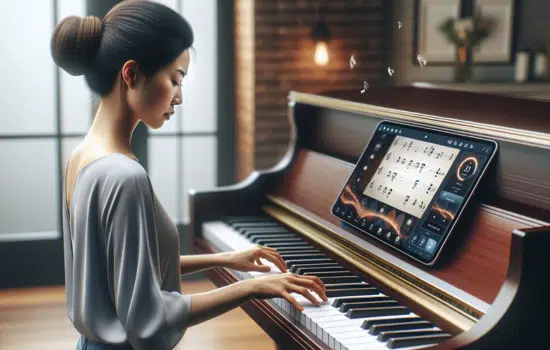Advertisements
Learning to play the piano has long been a dream for many music lovers. However, the perception that it takes a lot of time and dedication to master this instrument has discouraged many aspiring musicians.
What if we told you that it's now possible to learn to play the piano quickly and easily? In the digital age, mobile apps have revolutionized the way we learn, and the piano is no exception.
Advertisements
This article explores how modern technology has transformed music learning, highlighting one app in particular that promises to turn you into a piano master in record time.
Through interactive tools, personalized tutorials, and a user-friendly interface, this app not only makes the learning process more accessible, but also much more fun and motivating.
Advertisements
Additionally, the unique features that differentiate this app from others on the market will be discussed, allowing users to adapt to their own pace and learning style.
From beginner lessons to advanced techniques, this resource offers a comprehensive experience covering all aspects needed to develop your piano skills.
Immerse yourself in the world of piano with the ease and convenience offered by this app, and discover how you can unleash your musical potential in ways that previously seemed unattainable.
See also:
- Master motorcycle mechanics today!
- Connect instantly with Walkie Talkie today
- Become an expert in automotive mechanics
- Immerse yourself in the world of series
- Learn Korean with these great apps
Whether you're a beginner or already have some experience, the doors to musical mastery are now within your reach.
The rise of piano learning apps
In the digital age, learning new skills has taken a significant turn with the emergence of mobile apps, offering users the opportunity to acquire knowledge from the comfort of their homes.
Among these skills, the piano has emerged as one of the most popular instruments to learn through apps.
This boom is largely due to the accessibility and flexibility offered by these platforms, allowing people to learn at their own pace, without the need for a face-to-face instructor.
Developers have created apps that cover everything from basic to advanced levels, integrating audio recognition technology and detailed video tutorials.
This has made learning piano not only easier, but also more interactive and engaging for users of all ages.
Furthermore, the use of these apps has democratized access to music education, eliminating geographical and economic barriers that previously prevented many aspiring musicians from achieving their goals.
Key Features of Piano Learning Apps
When selecting a piano learning app, it's crucial to consider certain features that can enhance the learning experience.
One of the most important is the user interface, which should be intuitive and easy to navigate, allowing even beginners to get started without complications.
In addition, the content should be well-structured, offering progressive lessons that cover everything from basic music theory to advanced performance techniques.
Another vital feature is the real-time feedback system. Many modern piano apps use artificial intelligence technology to listen and evaluate the user's playing accuracy, providing suggestions for improvement in real time.
This simulates the experience of having a personal teacher offering immediate feedback, which is essential for effective learning. Incorporating challenges and interactive games can also make daily practice more fun and motivating.
Advantages of learning piano with apps
One of the most significant advantages of using piano learning apps is the flexibility they offer in terms of time and place. Users can access lessons at any time of day, adapting to their own schedules and lifestyles.
This is particularly beneficial for adults with busy schedules or students who want to complement their academic studies with music.
Additionally, cost is an important consideration. Apps are often more affordable than traditional lessons with a private teacher, making music learning more accessible to a wider audience.
Many apps offer free versions with subscription options that unlock additional content, allowing users to try them out before making a financial commitment.
Limitations and challenges of piano apps
Despite its many advantages, learning to play the piano exclusively through apps also presents certain challenges. One of the main limitations is the lack of human interaction that a live teacher can provide.
The personalized guidance and emotional feedback that a teacher can provide are difficult to replicate digitally.
This connection can be crucial for students who require additional motivation or who have specific learning difficulties.
Furthermore, while apps offer technical feedback, they may not capture more subtle nuances of musical performance, such as emotional expression and personal style.
These skills are often best developed with the guidance of an experienced mentor, who can impart knowledge that goes beyond the purely technical.
Exploring the most popular apps
Among the most renowned apps for learning to play the piano, some stand out for their innovative features and effective teaching methods. "Simply Piano," for example, is known for its user-friendly interface and focus on interactive practice.
Offers lessons for beginners and intermediate musicians, integrating popular songs that make learning more engaging and relevant.
Another notable app is “Flowkey,” which combines high-quality video tutorials with note detection technology, allowing users to play alongside professional pianists.
This not only helps improve technique but also introduces students to different musical styles. These apps and many others continue to evolve, incorporating new technologies and methodologies to enhance the learning experience.
Tips to maximize learning with piano apps
For those who want to get the most out of their piano learning experience through apps, adopting certain habits and strategies is essential.
First, establishing a regular practice schedule is crucial. Consistency is key to progress in any skill, and piano is no exception. Even short, daily sessions can be more beneficial than long, sporadic practices.
Additionally, it's recommended to complement the app's lessons with other educational resources, such as music theory books or online video tutorials. This can provide a broader understanding of the instrument and music in general.
Finally, students should be patient and realistic with their expectations. Learning to play an instrument is a gradual process and requires time and dedication.
The future evolution of piano apps
Looking to the future, the potential for piano apps remains vast. With rapid advances in technology, we're likely to see greater integration of augmented reality and artificial intelligence into these platforms.
This could offer even more immersive and personalized learning experiences, with the ability to tailor lessons to each user's individual needs and preferences.
Collaborations between app developers and professional musicians could also lead to exclusive content and innovative teaching techniques.
These partnerships have the potential to enrich learning by introducing students to the real world of music, connecting them with artists and virtual concerts.
The constant evolution of these apps promises to further democratize access to music education, inspiring future generations of pianists to explore their creativity and passion for music.

Conclusion
In conclusion, piano learning apps have revolutionized the way aspiring musicians approach learning the instrument.
Thanks to the accessibility and flexibility these platforms offer, more people than ever have the opportunity to become pianists from the comfort of their homes.
However, it's not just convenience that has driven its popularity; the incorporation of advanced technology, such as artificial intelligence and audio recognition, has made learning more interactive and effective.
Furthermore, apps have democratized music education, removing economic and geographic barriers that previously limited access to quality lessons.
However, it is crucial that users complement the use of these tools with regular practice and additional resources to maximize their progress.
While apps provide a solid foundation, the lack of human interaction and personalized guidance are challenges that remain.
Looking to the future, continued technological advancement and innovative collaborations promise to further enrich piano learning, inspiring new generations to explore their musical creativity and achieve their goals with greater ease.






